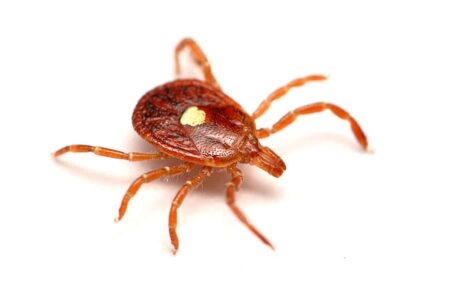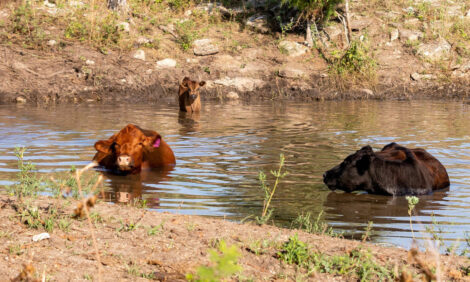



Estrus Detection In Cattle
Estrus in cattle is commonly referred to as heat. It occurs every 18 to 24 days in sexually mature, open (nonpregnant) female cattle when they are receptive to mounting activity by bulls or other cows or heifers, according to Dr. Jane A. Parish, Associate Extension/ Research Professor, Animal and Dairy Sciences; Dr. Jamie E. Larson, Assistant Professor, Animal and Dairy Sciences; and Dr. Rhonda C. Vann, Associate Research Professor, Brown Loam Branch Experiment Station.Heat detection is critical to heat synchronization and breeding programs, particularly artificial insemination and embryo transfer programs. Effective heat detection is often the most limiting factor in an artificial insemination program. Heat detection can also be used to monitor onset of puberty in heifers, regularity of estrous cycles in breeding age females, and breeding effectiveness of natural service sires via returns to heat in the cow herd.
Heat detection efficiency (rate) is the percentage of eligible cows seen or detected in heat. Eligible cows are cows eligible for insemination. Heifers have reached puberty if they have resumed normal estrus function (cycling) after calving (typically 40 days or more postcalving), are free of reproductive disorders or reproductive tract infections, and are open. A heat detection rate of 80 to 85 per cent should be attainable.
Heat Signs and Detection Methods
Several methods of heat detection can be implemented. Some involve using heat detection aids. Several different methods can be combined to improve heat detection rates and accuracy. These include visual observation, heat mount detectors, tailhead markers (paint, chalk, crayon, paste), chin-ball markers, detector animals, and electronic heat detection devices.
Visual Observation
Visual observation is a commonly used method of heat detection. It involves a trained observer’s recognizing and recording signs of heat. Observable signs of heat include mounting or attempting to mount other cattle, standing to be mounted by other cattle, smelling other females, trailing other females, bellowing, depressed appetite, nervous and excitable behavior, mud on hindquarters and sides of cattle, roughed up tail hair, vulva swelling and reddening, clear vaginal mucous discharge, and mucous smeared on rump.
The surest sign of heat is when a cow or heifer allows other cattle to mount her while she remains standing. This is called standing heat. Cattle may be willing to mount others but may not stand to be mounted when outside of standing heat. This usually indicates she is either coming into or going out of standing heat.
This method requires observation of cattle at least twice daily, typically early in the morning and late in the evening for best results. More frequent observation of cattle for heat improves detection accuracy and increases the likelihood of recognizing the optimal time for breeding cattle, particularly in cattle in which heat is less intense or shorter in duration. Nearly 20 percent more cattle will be observed in heat when checked four times per day versus checking twice daily. Check cattle as often as practical. Space heat detection observation times evenly over 24 hours. Each observation period must be sufficiently long, usually at least 30 minutes, to be effective.
Standing heat can occur any time in a 24-hour period. However, the most likely time for a cow or heifer to show heat signs is at night. The season of the year can influence this, with more cows showing heat at night in hot weather and more showing heat during the day in cold weather. Housing conditions can also have an effect on the distribution of heat during a 24- hour period. Hot weather, high production, crowded conditions, and high stress environments may reduce mounting activity.
|
Timeline for Heat Signs in Cattle
|
|||
|---|---|---|---|
|
.
|
Coming into Heat
|
Standing Heat
|
Going out of Heat
|
|
.
|
(8 hours)
|
(18 hours)
|
(14+ hours)
|
| Heat Signs |
|
|
|
Observers must distinguish among cattle coming into heat, in standing heat, and going out of heat. Females that are in standing heat, were in standing heat yesterday, or will be in standing heat tomorrow are the most likely herd mates to mount other cows or heifers in heat. Observe cows away from the feed bunk so feeding behavior does not interfere with heat detection. Cattle need nonslip footing and ample room to interact freely. Dirt footing increases mounting and standing activity more than concrete footing.
Heat Detection Aids
Heat detection aids are available. They should be used to supplement but not replace visual observation. These include tail paint, Kamar® Heatmount® Detectors, Estrotect™ Heat Detectors, Bovine Beacon®, tail head markers, chin-ball markers, and the HeatWatch® II System, an electronic detection system that records mounting behavior. Heat detection aids differ in their application method, detection method, cost per animal, and detection accuracy.
|
When Cows Show Heat
|
|
|---|---|
| Time | Cows showing heat signs, per cent |
| 6 am to noon | 22 per cent |
| noon to 6 pm | 10 per cent |
| 6 pm to midnight | 25 per cent |
| midnight to 6 am | 43 per cent |
Detector (teaser) animals can also assist in heat detection. Teaser animals include several types of gomer bulls, which are surgically altered to prevent successful insemination. Select gomer bulls that will not become excessively large. Acceptable disposition and freedom from disease are also important in gomer bulls.
Management Considerations
Good management is important for a successful heat detection program. Animals must have clearly readable, unique identification. An adequate area and equipment for heat detection must be available. This may include binoculars or the ability to approach cattle very closely. Nighttime observations may require artificial lighting, such as security lights, flashlights, or lanterns. Record keeping supplies such as paper, writing utensils, and clocks are important, along with a well-organised recordkeeping system.
Persons detecting heat must be well trained in heat detection and recording. Instruct all persons detecting heat to record cow or heifer ID, time of observation, and all signs of heat observed. Record all heat periods detected, even if the cow or heifer will not be bred on that heat. Then breeding wheels, calendars, or heat expectancy charts can be used to help predict future heats.
Summary
The effectiveness of detecting heat in cattle varies, depending on method used. Consider the cost, labor, and management system associated with each method in deciding on the best approach to heat detection. The purpose of heat detection also determines the level of heat detection accuracy needed. For more information on cattle reproduction or related topics, contact an office of the Mississippi State University Extension Service.
Heat Detection Aids
Kamar heatmount detector
ApplicationApply with separate adhesive between tail head and hop bone over the sacrum of cow.
Detection method
Detector remains white until triggered by weight of mounting animal, then it turns bright red.
Management considerations
Detectors may become partially activated, making it hard to tell if heat has occurred.
Detectors can become dislodged from female.
Approximate cost
$1-2/ head
Estrotect heat detector
ApplicationApply with self-adhesive between tail head and hip bone over the sacrum of cow and heifer.
Detection method
Detector remains silver until friction of mounting animal(s) reveals fluorescent colour under scratched-off silver layer.
Management considerations
Low branches, gates and other cattle can lead to a false positive.
Detectors can become dislodged from female.
Approximate cost
$1-2/ head
Bovine beacon
ApplicationGlue to tail head of cow or heifer.
Detection method
Contains fluorescent dye that glows in the dark when cow or heifer is mounted by another.
Management considerations
Low branches, gates and other cattle can lead to a false positive.
Detectors can become dislodged from female.
Approximate cost $1-2/ head
Tail head markers
ApplicationSmear liberal amounts (at least two to three inches wide) of crayon, chalk, paste or paint market on the tail head of cow or heifer.
Detection method
When marker is rubbed off tail head (hair will be ruffled and pulled back), the cow or heifer has stood to be mounted.
Management considerations
Low branches, gates and other cattle can lead to a false positive.
May need to reapply every few days.
Approximate cost
Less than $1/ head
Chin-ball marker
ApplicationFit marker device under the chin of a teaser bull or androgenised cow or heifer.
Detection method
An animal wearing the device mounts and slides of the cow or heifer in hear, leaving an ink mark on the back and hip of female.
Management considerations
Maintenance is necessary for continuous use (ink must be refilled)
Harness straps may break or stretch.
Some markings may be from chin's resting instead of mounting.
Approximate cost
$70-90/ harness, $30-40/ gallon ink
HeatWatch 11
Application
Place small, digital radio transmitter in a piece of polyester material (patch) and glue onto tailhead of cow or heifer.
Detection method
Every time there is a mount, data is sent from that transmitter to a small radio receiver (base station) in the proximity of the heat detection area. Data generated on every mount include the female counted, date and time of mount and duration (in seconds) of each mount.
Management considerations
Patches can become dislodged from females.
Transmitters can fall out of patchers if not adequately secured.
Batteries must have proper charge.
Increased heat detection accuracy over other aids.
Approximate cost
$3,950 HeatWatch 11 System (base station, access paint, software $945/ repeater, $49/ monitor, $3.75 per patch, $3.75/ 10.5 oz caulking tube of glue, $0.028/ volatile corrosion inhibitor (VCI) bag.
May 2010



